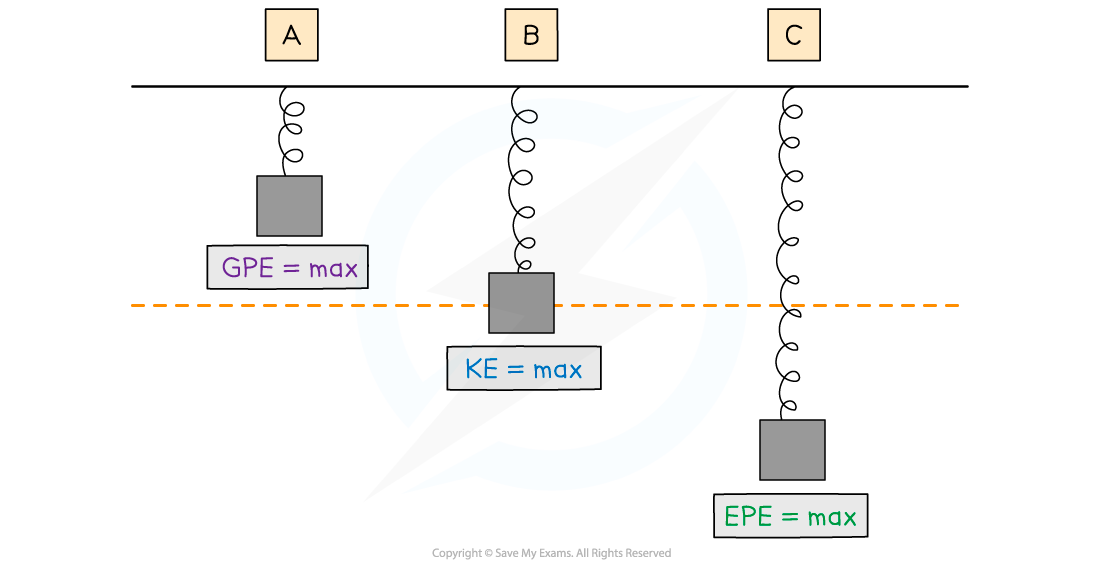KE, GPE & EPE (AQA GCSE Physics): Revision Note
Exam code: 8463
KE, GPE & EPE
When a mass on a vertical spring oscillates up and down, energy is transferred between stores
Although the total energy of the mass-spring system will remain constant, it will have changing amounts of energy in its:
Elastic potential energy (EPE) store
Kinetic energy (KE) store
Gravitational potential energy (GPE) store

Energy changes when a spring is stretched
At position A:
The spring has some energy in its elastic potential store since it is slightly compressed
The spring has zero energy in its kinetic store since it is stationary
The amount of energy in its gravitational potential store is at a maximum because the mass is at its highest point
At position B:
The spring has some energy in its elastic potential store since it is slightly stretched
The energy in its kinetic store is at a maximum as it passes through its resting position at its maximum speed
The spring has some energy in its gravitational potential store since the mass is still above its lowest point in the oscillation
At position C:
The energy in the elastic potential store of the spring is at its maximum because it is at its maximum extension
The spring has zero energy in its kinetic store since it is stationary
The energy in the gravitational potential store of the spring is at a minimum because it is at its lowest point in the oscillation
Worked Example
The diagram below shows a student before and after a bungee jump. The bungee cord has an unstretched length of 30.0 m.

The mass of the student is 60.0 kg. The gravitational field strength is 9.8 N / kg.
Calculate:
a) The change in gravitational potential energy of the student at 30.0 m
b) The maximum change in the gravitational potential energy of the student
c) The speed of the student after falling 30.0 m if 90% of the energy in the student's gravitational potential store is transferred to the student's kinetic store
d) The spring constant of the bungee cord if all the energy in the gravitational potential store of the student is transferred to the elastic potential store of the bungee cord
Answer:
Part (a)
Step 1: List the known quantities
Mass of the student, m = 60.0 kg
Gravitational field strength, g = 9.8 N/kg
Change in height, h = 30.0 m
Step 2: Write out the equation for gravitational potential energy
Step 3: Calculate the change in gravitational potential energy
Part (b)
Step 1: List the known quantities
Mass of the student, m = 60.0 kg
Gravitational field strength, g = 9.8 N/kg
Maximum change in height, h = 75.0 m
Step 2: Calculate the maximum change in gravitational potential energy
Part (c)
Step 1: List the known quantities
Mass of the student, m = 60.0 kg
at 30.0 m = 17 640 J
Step 2: Determine 90% of the at 30.0 m
Step 3: Write out the equation for KE
Step 4: Rearrange to make speed the subject
Multiply both sides by 2:
Divide both sides by m:
Take the square root of both sides:
Step 5: Calculate the speed
Part (d)
Step 1: List the known quantities
= 44 100 J
at 75.0 m =
Step 2: Determine the extension of the bungee cord
Step 3: Write out the equation for elastic potential energy
Step 4: Rearrange to make spring constant, k, the subject
Multiply both sides by 2:
Divide both sides by
:
Step 5: Calculate the spring constant
Examiner Tips and Tricks
If a question asks you to "state" a value, you do not need to carry out a calculation: The answer will almost certainly be a number either from a previous answer or which was given somewhere in the question.
For example, if you have just calculated the gravitational potential energy of an object and are then asked to state the kinetic energy a moment later, the answers are very likely to be the same.

Unlock more, it's free!
Did this page help you?